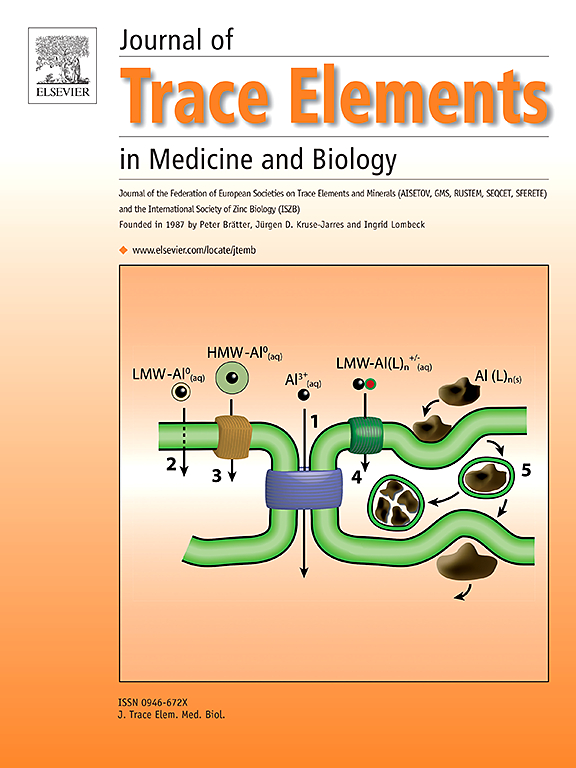四翅四胸草的改良作用。& Thonn.) taub利用体内和计算方法研究氯化镉诱导的黑胃果蝇氧化应激。
IF 3.6
3区 医学
Q2 BIOCHEMISTRY & MOLECULAR BIOLOGY
Journal of Trace Elements in Medicine and Biology
Pub Date : 2025-02-01
DOI:10.1016/j.jtemb.2024.127571
引用次数: 0
摘要
背景:镉(Cd)是一种天然存在的过渡金属,与生物体的氧化应激有关。而四胸草(Tetrapleura tetraptera, Tt)是一种民族药用植物,据说具有很高的抗氧化活性,用于治疗当地的各种人类疾病。因此,本研究旨在探讨四翅虫乙醇豆荚提取物对氯化镉致黑腹果蝇的生物活性。方法:选取1 ~ 日龄黑腹天牛成虫6组,分别饲喂对照组、Tt 2.5 mg/10 g饲粮、Tt 5 mg/10 g饲粮、CdCl2、CdCl2+Tt 2.5 mg/10 mg/10饲粮和CdCl2+Tt 5 mg/10 g饲粮,每瓶50只,每组5个重复,饲养7 d。之后,我们评估了自由基生成、抗氧化、非抗氧化活性和苍蝇羽化率的标记。Tt提取物的活性化合物与谷胱甘肽- s -转移酶II分子对接。结果:结果表明,CdCl2通过提高脂质过氧化(LPO)、过氧化氢(H2O2)、一氧化氮(NO)水平和降低GST活性显著诱导氧化应激,而对总硫醇(T-SH)和非蛋白硫醇(NP-SHs)水平无影响。然而,与四翅虫(2.5 mg/10 g日粮)共处理显著降低了LPO、H2O2水平,但增加了GST活性。与四夜蛾(5 mg/10 g日粮)共处理,NPSH和T-SH水平分别提高18.6 %和35.8 %。此外,联合处理(5 mg/10 g日粮)提高了后代的羽化率。结论:四翅虫可改善氯化镉诱导的黑腹果蝇氧化应激,提高后代的孵化率。因此,四翅虫可能是治疗镉诱导的氧化应激相关疾病的良好方案。本文章由计算机程序翻译,如有差异,请以英文原文为准。
Ameliorative role of Tetrapleura tetraptera (Schum. & Thonn.) taub in cadmium chloride-induced oxidative stress in Drosophila melanogaster using in vivo and computational approaches
Background
Cadmium (Cd) is a naturally occurring transition metal associated with oxidative stress in living organisms. Whereas Tetrapleura tetraptera (Tt), an ethnomedicinal plant is said to possess high antioxidant activity and used to treat various human diseases locally. Therefore, the study aimed to investigate the biological activity of the ethanolic pod extract of T. tetraptera in cadmium chloride-induced toxicity in Drosophila melanogaster.
Methods
Six groups of adults (1–3 days old) D. melanogaster as shown: Control, Tt 2.5 mg/10 g diet, Tt 5 mg/10 g diet, CdCl2, CdCl2+ Tt 2.5 mg/10 diet and CdCl2+Tt 5 mg/10 g diet were exposed via diet for 7 days consisting of 50 flies per vial and 5 replicate per group. Thereafter, we evaluated markers for free radical generation, antioxidant, non-antioxidant activities, and emergence rates of the flies. The active compounds of Tt extract were molecularly docked against glutathione-S-transferase II.
Results
The results indicated that CdCl2 significantly induced oxidative stress by increasing the levels of lipid peroxidation (LPO), hydrogen peroxide (H2O2), nitric oxide (NO) and decreasing the activity of GST without an effect on total thiol (T-SH) and non-protein thiols (NP-SHs) levels. However, co-treatment with T. tetraptera (2.5 mg/10 g diet) significantly decreased levels of LPO, H2O2, but increased GST activity. Also, co-treatment with T. tetraptera (5 mg/10 g diet) increased NPSH and T-SH levels by 18.6 % and 35.8 %. Furthermore, Co-treatment (5 mg/10 g diet) increased the rate of offspring emergence.
Conclusion
T. tetraptera ameliorated cadmium chloride-induced oxidative stress in Drosophila melanogaster and increased offspring hatching rate. T. tetraptera may therefore serve as a good regimen for the treatment of oxidative stress-related diseases induced by cadmium.
求助全文
通过发布文献求助,成功后即可免费获取论文全文。
去求助
来源期刊
CiteScore
6.60
自引率
2.90%
发文量
202
审稿时长
85 days
期刊介绍:
The journal provides the reader with a thorough description of theoretical and applied aspects of trace elements in medicine and biology and is devoted to the advancement of scientific knowledge about trace elements and trace element species. Trace elements play essential roles in the maintenance of physiological processes. During the last decades there has been a great deal of scientific investigation about the function and binding of trace elements. The Journal of Trace Elements in Medicine and Biology focuses on the description and dissemination of scientific results concerning the role of trace elements with respect to their mode of action in health and disease and nutritional importance. Progress in the knowledge of the biological role of trace elements depends, however, on advances in trace elements chemistry. Thus the Journal of Trace Elements in Medicine and Biology will include only those papers that base their results on proven analytical methods.
Also, we only publish those articles in which the quality assurance regarding the execution of experiments and achievement of results is guaranteed.

 求助内容:
求助内容: 应助结果提醒方式:
应助结果提醒方式:


